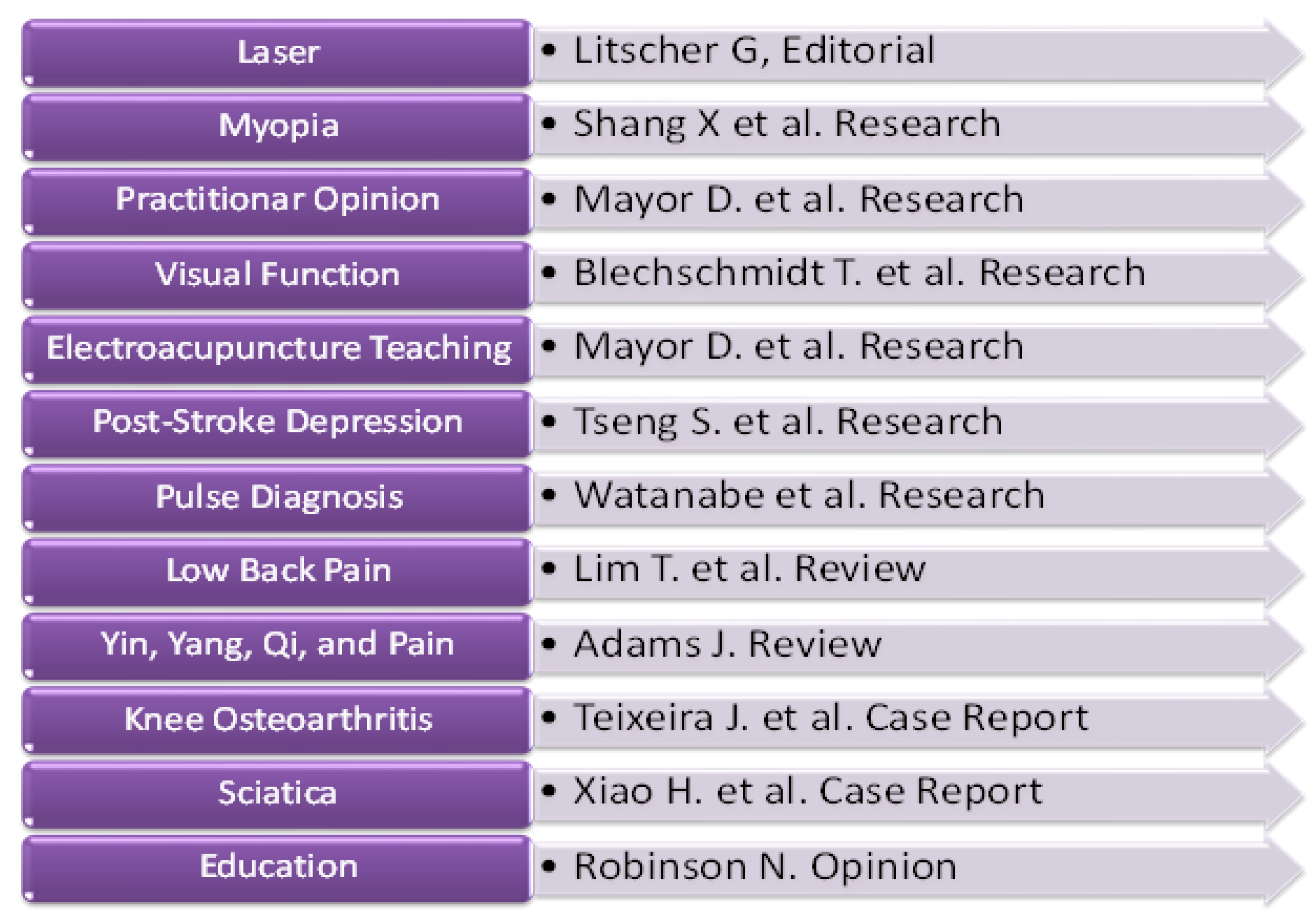Introduction to the Medicines Special Issue on Acupuncture—Basic Research and Clinical Application
Abstract
:Funding
Acknowledgments
Conflicts of Interest
References
- Litscher, G. Laser Acupuncture Research: China, Austria, and Other Countries—Update 2018. Medicines 2018, 5, 92. [Google Scholar] [CrossRef] [PubMed]
- Shang, X.; Chen, L.; Litscher, G.; Sun, Y.; Pan, C.; Liu, C.; Litscher, D.; Wang, L. Acupuncture and Lifestyle Myopia in Primary School Children—Results from a Transcontinental Pilot Study Performed in Comparison to Moxibustion. Medicines 2018, 5, 95. [Google Scholar] [CrossRef]
- Mayor, D.; McClure, L.; Clayton McClure, J. Individual Differences in Responsiveness to Acupuncture: An Exploratory Survey of Practitioner Opinion. Medicines 2018, 5, 85. [Google Scholar] [CrossRef] [PubMed]
- Blechschmidt, T.; Krumsiek, M.; Todorova, M. The Effect of Acupuncture on Visual Function in Patients with Congenital and Acquired Nystagmus. Medicines 2017, 4, 33. [Google Scholar] [CrossRef] [PubMed]
- Mayor, D.; McClure, L.; McClure, J. Nonspecific Feelings Expected and Experienced during or Immediately after Electroacupuncture: A Pilot Study in a Teaching Situation. Medicines 2017, 4, 19. [Google Scholar] [CrossRef] [PubMed]
- Tseng, S.; Hsu, Y.; Chiu, C.; Wu, S. A Population-Based Cohort Study on the Ability of Acupuncture to Reduce Post-Stroke Depression. Medicines 2017, 4, 16. [Google Scholar] [CrossRef] [PubMed]
- Watanabe, M.; Kaneko, S.; Takayama, S.; Shiraishi, Y.; Numata, T.; Saito, N.; Seki, T.; Sugita, N.; Konno, S.; Yambe, T.; et al. The Pilot Study of Evaluating Fluctuation in the Blood Flow Volume of the Radial Artery, a Site for Traditional Pulse Diagnosis. Medicines 2016, 3, 11. [Google Scholar] [CrossRef] [PubMed]
- Lim, T.; Ma, Y.; Berger, F.; Litscher, G. Acupuncture and Neural Mechanism in the Management of Low Back Pain—An Update. Medicines 2018, 5, 63. [Google Scholar] [CrossRef] [PubMed]
- Adams, J. The Effects of Yin, Yang and Qi in the Skin on Pain. Medicines 2016, 3, 5. [Google Scholar] [CrossRef] [PubMed]
- Teixeira, J.; Santos, M.; Matos, L.; Machado, J. Evaluation of the Effectiveness of Acupuncture in the Treatment of Knee Osteoarthritis: A Case Study. Medicines 2018, 5, 18. [Google Scholar] [CrossRef] [PubMed]
- Xiao, H.; Zaslawski, C.; Vardy, J.; Oh, B. Treatment of Sciatica Following Uterine Cancer with Acupuncture: A Case Report. Medicines 2018, 5, 6. [Google Scholar] [CrossRef] [PubMed]
- Robinson, N. Why We Need Minimum Basic Requirements in Science for Acupuncture Education. Medicines 2016, 3, 21. [Google Scholar] [CrossRef] [PubMed]

© 2018 by the author. Licensee MDPI, Basel, Switzerland. This article is an open access article distributed under the terms and conditions of the Creative Commons Attribution (CC BY) license (http://creativecommons.org/licenses/by/4.0/).
Share and Cite
Litscher, G. Introduction to the Medicines Special Issue on Acupuncture—Basic Research and Clinical Application. Medicines 2018, 5, 99. https://doi.org/10.3390/medicines5030099
Litscher G. Introduction to the Medicines Special Issue on Acupuncture—Basic Research and Clinical Application. Medicines. 2018; 5(3):99. https://doi.org/10.3390/medicines5030099
Chicago/Turabian StyleLitscher, Gerhard. 2018. "Introduction to the Medicines Special Issue on Acupuncture—Basic Research and Clinical Application" Medicines 5, no. 3: 99. https://doi.org/10.3390/medicines5030099
APA StyleLitscher, G. (2018). Introduction to the Medicines Special Issue on Acupuncture—Basic Research and Clinical Application. Medicines, 5(3), 99. https://doi.org/10.3390/medicines5030099




